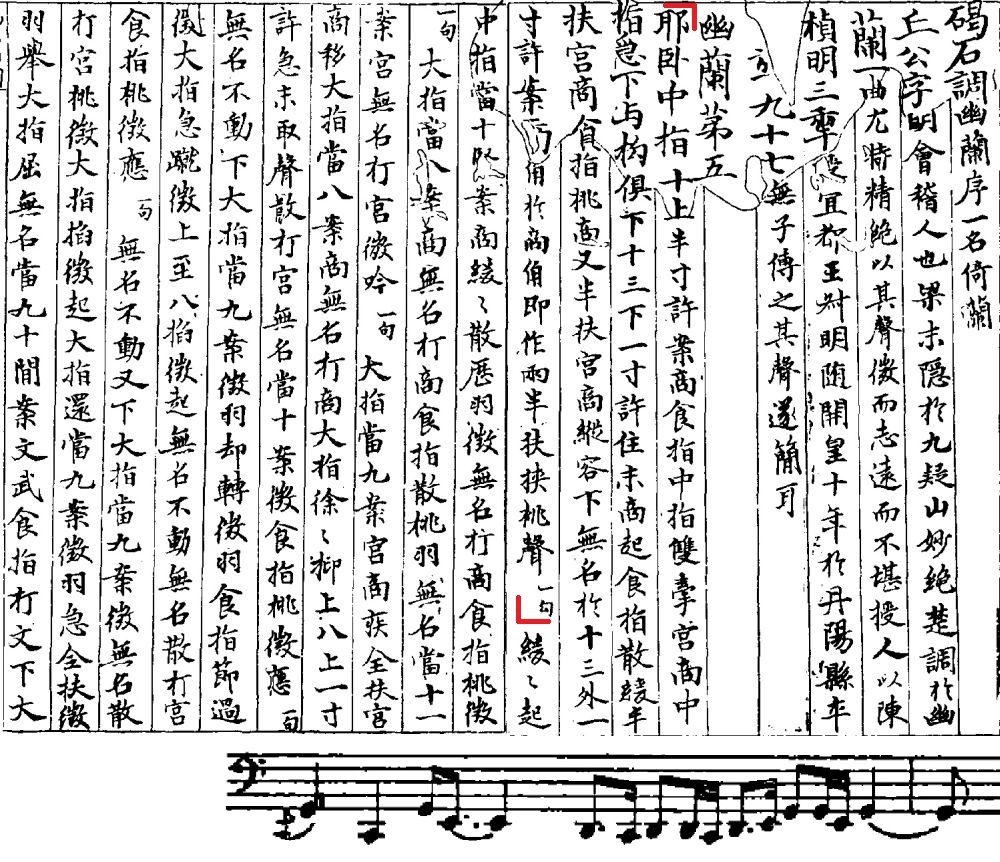Jieshi diao Youlan 碣石調幽蘭 is a book on the zither based on a melody allegedly written by Confucius, and first noted down by Qiu Ming 丘明 (493-590) during the Liang period 梁 (502-557). Youlan, also called Yilan 倚蘭, Yilan 猗蘭 or Yilan cao 猗蘭操, is perhaps the oldest surviving descriptive record of a zither tune (wenzipu 文字譜). Its key is jieshi diao 碣石調. Qiu Ming hailed from Guiji 會稽, Zhejiang, and lived in seclusion in the vales of Mt. Jiuyi 九嶷山. In 589, he decided to teach the melody to Wang Shuming 王叔明. The melody was thus invented in the 5th or 6th century, even if the legend says that when Confucius, disappointed by his travel from court to court, returned to his home country, he saw an orchid amidst simple grass. He lamented that this was the symbol of a ruler being forced to dwell amidst the common populace and created a sad melody.
 |
| [左]耶(=邪)臥中指十上半寸許案商,[右]食指中指雙(=兩次)牽宫商,[左]中指急下与构(=搆)[右]俱下十三下一寸許住,末商起,[右]食指散(=空弦)援(=慢)半扶宫商,食指挑商又半扶宫商,[左]縱容下無名(=小指)於十三外一寸許案商角,[右]於商角即作兩(=兩次)半扶挟挑聲。一句。 |
First phrase of the Youlan tune (in the image marked with red brackets). Because the plucking techniques have specific terms for the fingers of the left and the right hand, it is not necessary to indicate the hand. For modern readers, Wu (1962) has added this information. The manuscript is written in a mixed traditional and simplified style. The transcription into modern notation follows the experiment of Guan Pinghu 管平湖 and Wang Di 王迪, in Wu (1962). |
The manuscript where Qiu or Wang had noted down the melody was transmitted to Japan and only returned to China in the late 19th century. The melody, noted down in ancient style, was interpreted first by the zither player Yang Shibai 楊時百 (1864-1931), who also published the series Qinxue congshu 琴學叢書, where text and melody are found, transcribed into the common jianzipu 減字譜 notes and interpreted the literary description of the melody. Later on, the melody was also discovered in the books Wusilan zhifa 烏絲欄指法 and Qinshu daquan 琴書大全. In 1957, the melody and its interpretation were transposed into modern style by the Zhongguo Yinyue Xiehui 中國音樂家協會 and the Minzu Yinyue Yanjiusuo 民族音樂研究所.
Several collections of zither tunes, like Shenqi mipu 神奇秘譜, Xilutang qintong 西麓堂琴統 or Ziyuantang qinpu 自遠堂琴譜 also include the melodies Youlan or Yilan. Still, they are different from the Jieshi diao Youlan 碣石調幽蘭.
The key jieshi diao originated in a popular tune called Longxi xing 隴西行 that was standardized by Cao Cao 曹操 (Wei Wudi 魏武帝, 155-220), who created text to the melody. It is quite probable that the melody served as accompaniment to the dance Jieshi wu 碣石舞. The "darkened orchid" (Youlan) is also the topic of a poem of Bao Zhao 鮑照 (c. 414-466). It is also mentioned in Sima Xiangru's 司馬相如 (179-117 BCE) rhapsody Meiren fu 美人賦 from the Han period 漢 (206 BCE-220 CE).